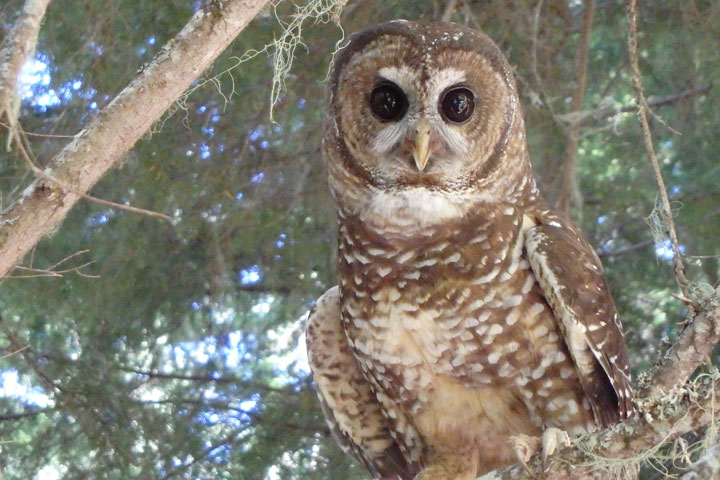The owls have come home to roost.
In a world convulsed by COVID-19, economic lockdowns, urban violence, and a presidential election, some may find it hard to believe that 30 years ago the nation was in the grips of a raging dispute over – owls. Not just any owl, mind you, but the northern spotted owl, a winged predator and longtime resident of the forests in the Pacific Northwest.
Even those who remember the conflict have for the most part filed it away, along with other “current events” that no longer seem current. But the spotted owl is back, and it’s back with a vengeance.
Rapidly spreading wildfires have laid waste to hundreds of thousands of acres of timberland and grassland, destroyed homes and businesses, and killed dozens of people in an area stretching from western Oregon south to Napa and Sonoma counties in California’s wine country. The fires took advantage of the region’s hopelessly overgrown forests, which provide combustible fuel for the destructive conflagrations.
And that’s where the spotted owl comes in.
As a result of the owl’s being placed on the federal Endangered Species List in 1990, severe restrictions were placed on the cutting of trees on millions of acres in the region’s national forests. The listing of the owl under the Endangered Species Act (ESA) devastated timber-dependent communities throughout the region and, as it turns out, inflicted enormous ecological harm on the region’s forests.
How it came to that is a story well worth retelling.
In 1987, a newly formed consortium, calling itself the Ancient Forest Alliance, which included the Wilderness Society, the Sierra Club, and like-minded groups, filed a petition with the U.S. Fish & Wildlife Service (FWS) to have the northern spotted owl listed as an endangered species under the ESA. The FWS rejected the petition, citing the lack of data showing the owl to be in trouble. Undaunted, local chapters of the National Audubon Society then filed separate suits against the U.S. Forest Service ad the Bureau of Land Management (BLM) questioning whether the owl could survive planned timber harvests on lands under their jurisdiction.
The environmentalists’ claims rested on the argument that the northern spotted owl, strix caurina occidentalis, one of several subspecies of spotted owl, was in danger of going extinct because its primary habitat, old-growth forests, was threatened by commercial logging. As the drama unfolded, the term “old-growth forests” became a staple of the debate over the owl. Foresters use the term “old-growth” in referring to forests in the final, or “climax,” phase of succession. In the forests of the Pacific Northwest, Douglas fir and Hemlock are the dominant trees, reaching 200 feet in height at maturity. Such old-growth forests make for good habitat for spotted owls and flying squirrels. But owls also thrive in younger forests, where their favorite prey, the northern flying squirrel and other rodents, are abundant. That the owl’s survival depended on millions of acres of timberland made off-limits to logging was an unfounded notion spread by environmentalists.
Truth aside, the emphasis on old-growth forests served an important public relations function for environmentalists. In the hands of skilled PR people, old-growth quickly be came “ancient,” inspiring even more reverence and awe in a public largely unfamiliar with the intricacies of forestry. The media eagerly joined the environmentalists’ cause, with Time magazine devoting a cover story to the owl. Prize-winning political cartoonist Dave Horsey portrayed loggers as stupid, brutish, uncaring thugs, eager to lay waste to nature. Yes, uncouth, blue-collar workers, who had never set foot in Yale Law School, were seen as “deplorables” long before Hillary Clinton coined the term.
The constant drumbeat worked like a charm. In June 1990, the FWS reversed its 1987 decision and declared the owl endangered under the ESA. In truth, the spotted owl was coming under pressure, but it had nothing to do with old-growth forests and nothing to do with logging. Barred owls began moving west from forests in Canada and Minnesota in the early 1900s and had made their way into the Pacific Northwest by the 1970s. Larger and more aggressive than the spotted owl, the barred owl successfully invaded the smaller owl’s territory and began winning the competition for prey and thus survival. In fact, the barred owl was known to be causing problems for is smaller cousin at the time of the debate over what to do with the spotted owl, but this was swept under the rug in the rush to save “ancient forests.”
Ecological Consequences of Green Orthodoxy
Today, those overgrown forests are tinderboxes that threaten wildlife, local residents, firefighters, not to mention many of the very trees – and owls — the ESA listing was supposed to protect.
Mismanagement of national forests predates the spotted owl controversy. Beginning in the middle of the last century, the U.S. Forest Service began practicing an aggressive policy of fire suppression. All forest fires, even small, beneficial fires that clear out undergrowth and dead and diseased trees, were ruthlessly suppressed, leading to the dangerous overgrowth that was well underway when the spotted owl was put on the Endangered Species List. The listing, which resulted from a flawed narrative, made a bad situation worse.
This is exactly what you get when sound forestry management is abandoned in favor of green orthodoxy. For green activists carrying the banner of the spotted owl, the goal was not to save either the bird or the forests; it was to bring about the regulatory destruction of the region’s timber-dependent communities. This is what writer Ron Arnold has referred to as “rural cleansing.” But in going after lumberjacks and their families, they also helped bring about the wildfires that are now ravaging the Pacific Northwest.
